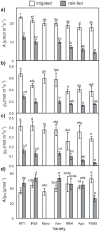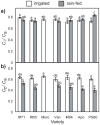Photosynthetic diffusional constraints affect yield in drought stressed rice cultivars during flowering
- PMID: 25275452
- PMCID: PMC4183539
- DOI: 10.1371/journal.pone.0109054
Photosynthetic diffusional constraints affect yield in drought stressed rice cultivars during flowering
Erratum in
-
Correction: Photosynthetic diffusional constraints affect yield in drought stressed rice cultivars during flowering.PLoS One. 2015 Feb 19;10(2):e0117631. doi: 10.1371/journal.pone.0117631. eCollection 2015. PLoS One. 2015. PMID: 25695248 Free PMC article. No abstract available.
Abstract
Global production of rice (Oryza sativa) grain is limited by water availability and the low 'leaf-level' photosynthetic capacity of many cultivars. Oryza sativa is extremely susceptible to water-deficits; therefore, predicted increases in the frequency and duration of drought events, combined with future rises in global temperatures and food demand, necessitate the development of more productive and drought tolerant cultivars. We investigated the underlying physiological, isotopic and morphological responses to water-deficit in seven common varieties of O. sativa, subjected to prolonged drought of varying intensities, for phenotyping purposes in open field conditions. Significant variation was observed in leaf-level photosynthesis rates (A) under both water treatments. Yield and A were influenced by the conductance of the mesophyll layer to CO2 (g(m)) and not by stomatal conductance (g(s)). Mesophyll conductance declined during drought to differing extents among the cultivars; those varieties that maintained g(m) during water-deficit sustained A and yield to a greater extent. However, the variety with the highest g(m) and yield under well-watered conditions (IR55419-04) was distinct from the most effective cultivar under drought (Vandana). Mesophyll conductance most effectively characterises the photosynthetic capacity and yield of O. sativa cultivars under both well-watered and water-deficit conditions; however, the desired attributes of high g(m) during optimal growth conditions and the capacity for g(m) to remain constant during water-deficit may be mutually exclusive. Nonetheless, future genetic and physiological studies aimed at enhancing O. sativa yield and drought stress tolerance should investigate the biochemistry and morphology of the interface between the sub-stomatal pore and mesophyll layer.
Conflict of interest statement
Figures







References
-
- Pandey S, Bhandari H, Ding S, Prapertchob P, Sharan R, et al. (2007) Coping with drought in rice farming in Asia: insights from a cross-country comparative study. Agricultural Economics 37: 213–224.
-
- Serraj R, McNally KL, Slamet-Loedin I, Kohli A, Haefele SM, et al. (2011) Drought resistance improvement in rice: an integrated genetic and resource management strategy. Plant Production Science 14: 1–14.
-
- Parent B, Suard B, Serraj R, Tardieu F (2010) Rice leaf growth and water potential are resilient to evaporative demand and soil water deficit once the effects of root system are neutralized. Plant, Cell & Environment 33: 1256–1267. - PubMed
-
- Peng S, Cassman KG, Virmani SS, Sheehy J, Khush GS (1999) Yield potential trends of tropical rice since the release of IR8 and the challenge of increasing rice yield potential. Crop Science 39: 1552–1559.
-
- Hubbart S, Peng S, Horton P, Chen Y, Murchie EH (2007) Trends in leaf photosynthesis in historical rice varieties developed in the Philippines since 1966. Journal of Experimental Botany 58: 3429–3438. - PubMed
Publication types
MeSH terms
Substances
LinkOut - more resources
Full Text Sources
Other Literature Sources

